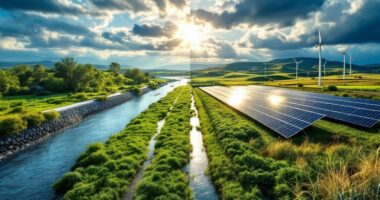Environmental monitoring technologies function like Earth’s sophisticated health tracking system. Satellites and drones capture visual data from above, while ground-based tools like LiDAR and IoT sensors measure everything from forest canopies to air quality. Underwater, automated sampling devices evaluate aquatic ecosystem parameters. AI and machine learning transform this data deluge into actionable insights about ecological trends. These interconnected technologies enable scientists to detect subtle environmental shifts that might otherwise go unnoticed.

The silent sentinels of our planet’s health, environmental monitoring technologies have revolutionized how scientists track and understand ecological changes. From the stratosphere to the soil beneath our feet, an array of sophisticated gadgets now keeps tabs on Mother Nature’s crucial signs with unprecedented precision.
Watchful technological eyes, measuring Earth’s pulse across every ecosystem, from clouds to microbes
These technological marvels act like Earth’s medical monitoring system, revealing subtle shifts that would otherwise remain invisible to researchers. Satellites circle overhead, capturing imagery that tells tales of deforestation, urban sprawl, and coral reef decline. Meanwhile, drones buzz closer to the action, providing high-resolution snapshots of specific ecosystems without disturbing a single leaf.
LiDAR—essentially light-based radar—creates 3D maps of forest canopies with such detail you’d think trees were posing for a digital portrait. Down on the ground, wireless sensor networks form a chatty web of data collectors.
These IoT devices are like neighborhood gossips, constantly sharing updates about temperature fluctuations, soil moisture, and air quality. Advanced systems like HORIBA’s technology continuously monitor meteorological parameters such as wind direction and barometric pressure to provide comprehensive environmental data. These environmental sentinels measure critical air pollutants including particulate matter and harmful gases to protect public health. Imagine thousands of tiny weather reporters stationed throughout a forest, each broadcasting minute-by-minute updates without coffee breaks or vacation days.
Water bodies get their own high-tech treatment with automated sampling devices and multi-parameter sondes—underwater probes that measure everything from pH to dissolved oxygen. These aquatic investigators don’t mind getting wet; in fact, they prefer it. Regular water sampling techniques ensure that data on chemical, physical, and biological parameters accurately reflect ecosystem health.
Camera traps patiently wait for wildlife to trigger their shutters, while bioacoustic recorders capture nature’s orchestra—from the deep rumble of elephants to the high-pitched chirps of bats. eDNA sampling takes detective work to microscopic levels, identifying species from the genetic breadcrumbs they leave behind in water.
All this environmental eavesdropping generates mountains of data that would overwhelm human analysts. Enter artificial intelligence and machine learning algorithms—the pattern-recognizing prodigies that sift through information faster than a cheetah on espresso.
Cloud computing platforms store this treasure trove, making it accessible to researchers worldwide. Together, these technologies form an essential toolkit for environmental scientists—the stethoscope, MRI, and blood tests for our planet’s check-ups.
Frequently Asked Questions
How Much Do Environmental Monitoring Technologies Typically Cost?
Environmental monitoring technologies vary widely in cost.
Standard automatic systems range from $100,000 to millions, while low-cost air quality sensors run $100-$2,500 per unit.
Enterprise-level systems typically start at $10,000-$50,000.
Beyond initial costs, organizations face ongoing expenses: maintenance (10-15% of initial price annually), calibration ($500-$2,000 per sensor yearly), and data management ($5,000-$20,000 annually).
Final costs depend on monitoring parameters, geographic scale, measurement frequency, and regulatory requirements.
What Training Is Required to Use These Monitoring Tools?
Operating environmental monitoring tools requires extensive training across several domains. Users need foundational knowledge in environmental science, data collection techniques, and applicable regulations.
Specific training on equipment calibration, maintenance, and proper deployment is essential. Many positions require formal certifications like CEP or REM credentials, along with specialized training for hazardous environments (HAZWOPER).
Professionals must also commit to ongoing education to stay current with evolving technologies, software applications, and regulatory standards.
How Accurate Are Remote Sensing Technologies Compared to Field Methods?
Remote sensing technologies typically demonstrate 43-96% greater accuracy than human ground counts, though this varies by application.
Vegetation mapping achieves 70-95% accuracy, while water quality monitoring reaches up to 90% for certain parameters.
Environmental factors like atmospheric conditions and spatial resolution limitations can affect reliability.
Most experts agree that integrating remote sensing with field methods provides the most thorough environmental assessments, with each approach compensating for the other’s limitations.
Can Monitoring Technologies Work Effectively in Extreme Weather Conditions?
Modern monitoring technologies are specifically engineered for extreme conditions. Rugged sensors with IPX4 weather resistance can function reliably in rain and wind, while thermosyphons protect equipment in thawing permafrost areas.
Manufacturers like FTS and AEM design systems that withstand harsh environments through ruggedized housings, wired connections that eliminate battery failures, and redundant systems.
For truly extreme locations, specialized adaptations like lithium batteries for cold temperatures and solar power solutions guarantee continuous operation when conventional systems would fail.
How Often Should Monitoring Equipment Be Calibrated and Maintained?
Monitoring equipment calibration schedules vary by device type and usage conditions.
Gas detectors and environmental monitoring systems typically require calibration every 6 months, while particle counters need annual attention.
Pre-filters should be replaced approximately 6 times yearly, with HEPA/ULPA filters lasting 4-6 years.
Manufacturers’ recommendations provide baseline guidance, but usage frequency, environmental conditions, and measurement criticality may necessitate adjustments.
Regular calibration guarantees data accuracy, identifies potential equipment issues early, and maintains regulatory compliance while optimizing equipment lifespan.









